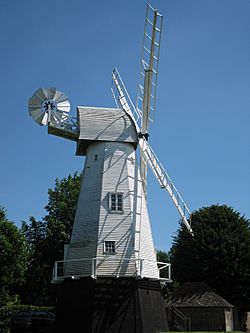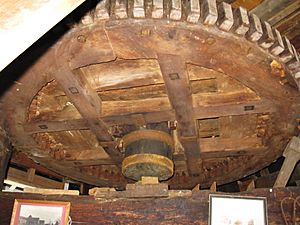Heritage Mill, North Chailey facts for kids
Quick facts for kids North Chailey Windmill |
|
|---|---|

The mill in 2009
|
|
| Origin | |
| Mill name | Heritage Mill Beard's Mill |
| Mill location | TQ 386 214 |
| Coordinates | 50°58′30″N 0°01′37″W / 50.975°N 0.027°W |
| Operator(s) | Chailey Heritage Mill Trust |
| Year built | Mid-19th century |
| Information | |
| Purpose | Corn mill |
| Type | Smock mill |
| Storeys | Three-storey smock |
| Base storeys | Single-storey base |
| Smock sides | Eight sides |
| No. of sails | Four sails |
| Type of sails | Patent sails |
| Windshaft | Cast iron |
| Winding | Fantail |
| Fantail blades | Eight blades |
Heritage Mill, also known as Beard's Mill, is a special type of windmill called a smock mill. It's located in North Chailey, Sussex, England. This mill is a historic building, meaning it's protected because of its importance. It's kept in good condition and people can visit it to learn about its past.
Contents
The Mill's Journey Through Time
Early Windmills at Chailey
People have used windmills at this spot for a very long time. The first record of a windmill here dates all the way back to 1596. Imagine how many different mills have stood on this same ground over the centuries!
Building and Moving Heritage Mill
Heritage Mill, the one you see today, is actually the seventh mill to be built on this site. It was first constructed in 1830 in a place called Highbrook, near West Hoathly. Back then, it was known as Hammingden Mill.
In 1844, the mill was moved for the first time. It traveled to Newhaven to replace another mill that had unfortunately burned down. However, it didn't stay there forever. When a new steam-powered mill was built, Heritage Mill was no longer needed.
So, it was moved again! This time, it came to its current home in Chailey. It replaced an older type of mill called a post mill. A skilled mill builder from Lewes named Medhurst handled this big move. Heritage Mill was grinding grain using wind power until 1911.
Challenges and Repairs
Windmills are powerful, but they can also be damaged by strong winds. In 1928, a very strong tailwind hit Heritage Mill. This caused the top part of the mill, called the cap, and its large sails to be blown off.
The mill was carefully repaired in 1933 by a company called Neve's, who were mill builders from Heathfield. But just a few years later, another strong tailwind struck. This time, the main shaft that held the sails, called the windshaft, broke. Neve's helped again by installing a new windshaft from another mill that had been taken apart.
What Heritage Mill Looks Like
Heritage Mill is a three-storey smock mill. This means its main body looks a bit like a person wearing a smock (a loose shirt). It sits on a strong, single-storey brick base.
The top of the mill, called the cap, is built in a special "Kentish-style." It has a fantail at the back. A fantail is a small windmill that automatically turns the main cap and sails into the wind, so the mill always catches the most breeze.
When the mill was working, it had four large sails. These were "Patent sails," which means they could be adjusted easily from inside the mill. The sails were connected to a strong cast-iron windshaft. Today, the only original machinery left inside is a large gear called the clasp arm great spur wheel. This wheel helped transfer power from the wind to the grinding stones.
People Who Ran the Mill
Many different millers worked at Heritage Mill and the mills before it. They were the people who operated the mill, grinding grain into flour for the local community. Here are some of the millers who worked there:
- John Arnold (1841)
- Bollen (1844)
- Messrs Stone & Towner (1864)
- Godley
- Thomas Comber
- H K Wallis (1870)
- A G Sparkes (1874)
- Lockyer (1878–1911)


